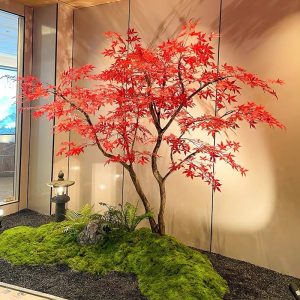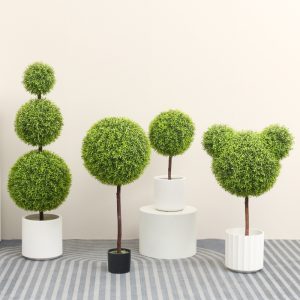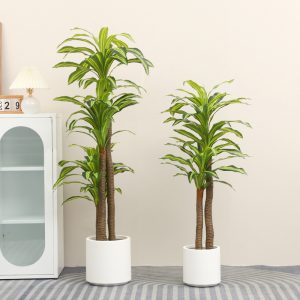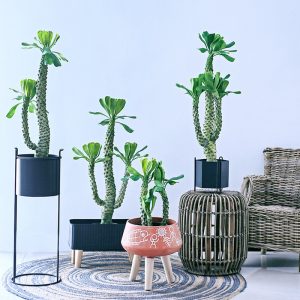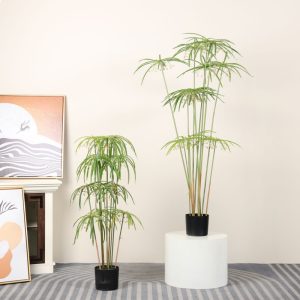After years in the artificial plant industry, I’ve found that many people still hold the misconception that “artificial plants are made of plastic flowers and grass, so how can they be eco-friendly?” While this may sound reasonable, it’s actually a half-truth! Environmental friendliness isn’t about being “natural,” it’s about considering the whole life cycle—from production to disposal—and evaluating the total resource consumption and environmental impact. Today, I’m here to provide a thorough breakdown of the eco-friendly benefits of artificial plants.
1. Materials Are Not What You Think: From “Bad Reputation” to “Green Technology”
Old Materials’ “Makeover”:
- PVC’s Comeback: Early PVC used plasticizers like phthalates, which were highly criticized. But now, mainstream manufacturers no longer use these toxic substances. Modern PVC uses soybean oil as an epoxy replacement, and heavy metal content is strictly controlled below 0.1ppm, meeting EU REACH standards. The biggest upgrade? PVC’s recycling rate has increased from 30% to over 85%, and waste material is now effectively reused.
- PE Goes “Low Carbon”: Traditional PE used petroleum, but many manufacturers now use bio-based PE derived from sugarcane. This process reduces carbon emissions by 60%, and these PE leaves can degrade by 60% in the natural environment within 5 years.
New Materials’ “Disruptive Innovation”:
- Plastic Bottles Turn into Leaves: By recycling PET bottles and spinning them into artificial plant leaves, every 5 discarded bottles can create one medium-sized artificial plant. This process saves up to 80% of the petroleum used, and it currently holds 25% of the market share in the artificial flower industry, growing every year.
- Mushroom “Planted” Flower Pots: Agricultural waste such as corn cobs and straw can be used to feed fungi, which then grow into structures that serve as plant pots or supports. Within 3 months, these structures naturally decompose, achieving zero waste.
- “Biodegradable” PU: Premium artificial plants often use PU material, and when mixed with 20% bamboo fiber, it can degrade 90% in compost conditions within 180 days. The artificial effect remains unchanged.

2. Resource Consumption Showdown: The “Hidden Powers” of Artificial Plants
Water Savings? Crushing Victory!
- A typical indoor pothos plant requires 1500 liters of water over its 5-year life cycle (equivalent to 12 large water bottles).
- A landscape tree requires 2000 liters of water annually for irrigation and equipment use.
In contrast, artificial plants only require 10 liters of water over 5 years—mostly for cleaning and processing during production—making their water consumption 150 times lower.
Real-World Example: In Dubai, a hotel replaced 30% of its real plants with artificial plants and saved 120,000 liters of water annually—enough to sustain 30 households for a month. In water-scarce regions, artificial plants have become part of municipal water-saving plans.
Carbon Emissions? A Full-Cycle Comparison!
Don’t just focus on the production phase—the entire life cycle (LCA) is the key factor in determining environmental impact:
- Production Phase: The carbon emissions from producing artificial plants are relatively high (around 5kg CO₂e for a medium-sized plant), which is 5 times higher than a seedling.
- Usage Phase: Real plants have high maintenance costs, including cold-chain transport, fertilizers, and electric tools. Over a 5-year cycle, real plants emit around 25kg CO₂e, while artificial plants only emit about 2kg CO₂e—1/12.5 of real plants’ emissions.
- End-of-Life Phase: Real plants in landfills release methane (which is 25 times more potent than CO₂ in terms of greenhouse effect), while artificial plants enter the recycling chain, reducing waste carbon emissions by 80%.
Total Carbon Emissions (5-year Cycle): The total carbon emissions from artificial plants are approximately 7kg CO₂e, while real plants emit 26kg CO₂e—artificial plants’ emissions are only 27% of real plants’. The more durable the artificial plant, the more carbon advantage it gains.
3. Want Real Sustainability? Focus on “Longevity + Complete Disposal”
Longevity Is Key:
High-quality artificial plants can last 5-7 years, which is 2-3 times longer than low-quality ones, saving significant production resources.
Repairability: Thanks to modular designs (where leaves and branches can be replaced individually), the repair rate of artificial plants can reach 70%, avoiding the waste of “throwing away once broken.”
Lifetime Maintenance: Some brands offer “lifetime maintenance” services, which can extend the average lifespan of plants to 10 years, meaning customers only need to repurchase once in 8 years.
Recycling Loop:
- Material QR Codes: The industry is pushing for “material QR codes,” allowing consumers to scan a code and know the proper recycling method for the product (e.g., PVC recycling, fabric donation, etc.).
- Brand Recycling Services: Some brands offer discounts when trading in old artificial plants for new ones, with a 10% discount. The metal frames from these plants can be reused up to 90%, and plastic parts have a 60% recycling rate.
- Advanced Recycling Tech: Complex composite plastics can now be chemically depolymerized back into raw materials with a purity of 99.5%, and these technologies are already being implemented by some companies.
4. No Exaggeration: The “Red Line” of Eco-Friendly Artificial Plants
Low-Quality Products Are a Pollutant Source!
Around 30% of low-priced artificial plants (with a lifespan of less than 1 year) use unrecyclable mixed plastics, which are the true “enemy” of the environment.
Microplastic Leakage: Low-quality PVC plants, after 3 years of use, can release an average of 1.2mg of microplastics per day (according to tested data). Avoid purchasing these low-priced products, especially those that are 50% cheaper than the industry average.
The Unique Value of Real Plants Can’t Be Replaced!
Real plants offer unique benefits such as air purification, formaldehyde absorption, oxygen release, and biodiversity enhancement—these are advantages that artificial plants cannot replace. Make rational choices: if your space has good sunlight, grow real plants, but if it’s a water-intensive or difficult-to-maintain environment, or a commercial space, artificial plants are the ideal option.
5. Consumer Action Guide: Spend Your Money Where It Counts for the Environment
Smart Purchases:
- Confirm whether the product description mentions a lifespan of over 5 years and has a clear recycling policy. Avoid buying “one-time-use” artificial plants.
- Choose products with recycled material labels (e.g., 30%+ recycled PET).
Proper Disposal:
- Check if the brand offers recycling services on their official website.
- If handling it yourself, make sure to place plastic parts in recycling bins and donate fabric parts to crafters.
Maximize Usage:
- By cleaning, repairing, and refurbishing, you can extend the lifespan of artificial plants by 1.5 times their design life—this is the greatest contribution you can make to the environment.
Industry Trend: Consumers are increasingly concerned about environmental impact, and eco-friendly features have become the third largest factor in purchasing decisions for artificial plants (after realism and price). 62% of people are willing to pay a 10%-20% premium for eco-friendly products, and the percentage of artificial plants made with recycled materials has increased from 17% in 2020 to 38% in 2024.








